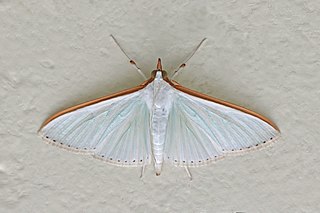
Diaphania is a genus of moths of the family Crambidae.

Diaphania indica, the cucumber moth or cotton caterpillar, is a widespread but mainly Old World moth species. It belongs to the grass moth family, and therein to the large subfamily Spilomelinae. This moth occurs in many tropical and subtropical regions outside the Americas, though it is native to southern Asia; it is occasionally a significant pest of cucurbits and some other plants.

Diaphania hyalinata, the melonworm moth, is a moth of the family Crambidae. It is found in eastern North America, south to Central and South America, including Suriname and the Caribbean.

Diaphania costata, the orange-shouldered sherbet moth or erroneously the white palpita moth, is a moth of the family Crambidae. The species was first described by Johan Christian Fabricius in 1794. It is widely dispersed, being found in the Indomalayan realm, as well as Europe. It is also found in Mexico and Texas, possibly having been introduced accidentally.
Diaphania equicincta is a moth in the family Crambidae. It was described by George Hampson in 1912. It is found in Mexico, Guatemala and Costa Rica.
Diaphania oeditornalis is a moth in the family Crambidae. It was described by George Hampson in 1912. It is found in Guatemala and Venezuela.
Diaphania columbiana is a moth in the family Crambidae. It was described by George Hampson in 1899. It is found in Guatemala, Colombia, Ecuador, Peru, Bolivia and Paraguay.
Diaphania novicialis is a moth in the family Crambidae. It was described by William Schaus in 1912. It is found in Costa Rica and Colombia.
Diaphania contactalis is a moth in the family Crambidae. It was described by Paul Dognin in 1903. It is found in Colombia, Venezuela, Brazil, Peru, Ecuador and Bolivia. The habitat consists of cloud forests.
Diaphania semaphoralis is a moth in the family Crambidae. It was described by Paul Dognin in 1903. It is found in Costa Rica, Colombia, Bolivia, French Guiana and Peru.
Diaphania infimalis is a moth in the family Crambidae. It was first described by Achille Guenée in 1854. It is found in Florida, Mexico, Guatemala, Belize, the Bahamas, Cuba, Jamaica, Panama, Venezuela and Bolivia.
Diaphania latilimbalis is a moth in the family Crambidae. It was described by Achille Guenée in 1854. It is found in Mexico, Guatemala, Honduras, Venezuela and Brazil. The habitat consists of tropical rainforests and cloud forests.

Diaphania plumbidorsalis is a moth in the family Crambidae. It was described by Achille Guenée in 1854. It is found in Mexico, Venezuela, French Guiana, Suriname, Bolivia, Peru, and Brazil.
Diaphania translucidalis is a moth in the family Crambidae. It was first described by Achille Guenée in 1854. It is found in Mexico, Guatemala, Costa Rica, Puerto Rico, the Dominican Republic, Venezuela, Brazil, Peru and Bolivia.
Diaphania arguta is a moth in the family Crambidae. It was described by Julius Lederer in 1863. It is found in Florida, Mexico, Guatemala, Costa Rica, Panama, Colombia, Venezuela, Trinidad, Tobago, Guyana, French Guiana, Suriname, Brazil, Peru and Bolivia.
Diaphania elegans is a moth in the family Crambidae. It was described by Heinrich Benno Möschler in 1890. It is found in Puerto Rico, Hispaniola, Jamaica, Cuba, Costa Rica, Panama, Guatemala, Honduras, Mexico and southern Texas. It is also found in South America, where it has been recorded from Venezuela, Trinidad, Ecuador, Peru, Brazil, Paraguay and Argentina.
Diaphania fuscicaudalis is a moth in the family Crambidae. It was described by Heinrich Benno Möschler in 1881. It is found in Brazil and Ecuador.
Diaphania guenealis is a moth in the family Crambidae. It was described by Snellen in 1875. It is found in Colombia, Venezuela, Ecuador, Peru, Belize and Mexico.
Diaphania lualis is a moth in the family Crambidae. It was described by Gottlieb August Wilhelm Herrich-Schäffer in 1871. It is found in Cuba, Mexico, southern Texas and Florida.
Diaphania lucidalis is a moth in the family Crambidae. It was described by Jacob Hübner in 1823. It is found in Panama, Grenada, Cuba, Jamaica, Venezuela, Ecuador, Brazil, Bolivia and Paraguay.




